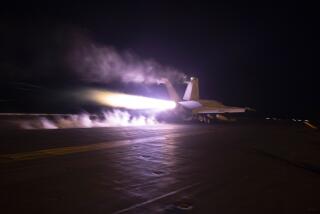Attacks Put Vinson Pilots on Guard
- Share via
ABOARD THE USS CARL VINSON — As the battle intensifies for the Taliban stronghold of Kandahar, U.S. fighter pilots are facing a barrage of antiaircraft fire of surprising intensity, pilots here report.
In the first weeks of the U.S. air war, planes from the Carl Vinson and two other aircraft carriers, as well as from land bases, quickly knocked out most of the enemy’s air defenses in Afghanistan’s northern, more mountainous regions.
But as the war has largely shifted to the southern province of Kandahar, U.S. planes are encountering fire from a variety of sources, including shoulder-held rockets, aging antiaircraft batteries and AK-47 machine guns left behind by the Soviet army.
Although the fire does not appear to be able to reach the altitude at which the planes are operating, it remains proof for pilots that the air campaign is still risky and the Taliban remains dangerous.
“We’re all talking about it,” said Lt. j.g. Abe Bush, an F/A-18 pilot with a squadron from Lemoore Naval Air Station in California’s San Joaquin Valley. “They’re becoming a lot more active, probably because they’re more organized in a smallish area. . . . I’m surprised they’re still fighting [after] they’ve taken some extreme hits.”
On Saturday, air squadrons from the Vinson launched their largest bombing mission of the war. None of the planes in Bush’s squadron, the Mighty Shrikes, returned to the carrier with unexpended ordnance, a rarity in previous weeks when pilots were hampered by poor visibility or lack of targets.
Three other carriers have taken the fight to Afghanistan, but none has stayed on station longer or launched more airstrikes than the Vinson.
“She’s getting old,” Command Master Chief Petty Officer Phil Salcido, assigned to one of the air squadrons, said of the Vinson. “But she still packs a lot of firepower.”
The Bremerton, Wash.-based ship, commissioned in 1982, left port July 23. It is set to be relieved soon by the San Diego-based John C. Stennis, which left port three weeks ago.
“Everybody is ready to go home. These kids are tired,” said Salcido, 46, who has seen 18 deployments on carriers in his 27 years in the Navy. He was on the Enterprise during the evacuation of Saigon and on the Ranger during Operation Desert Storm. The secret to coping with the stress of long days of launching and retrieving warplanes, Salcido said, is sticking to a routine and looking for ways to keep spirits up.
Morale-boosting has been made more difficult by the fact that, since Sept. 11, the Vinson has had to forgo planned port calls to Australia, Bahrain and the United Arab Emirates. As compensation, the captain invoked a Navy rule that allows each sailor to have two beers when the ship has been at sea without a port call for 45 days.
A “steel-beach party” was held on the flight deck on one of only two days on which the Vinson did not launch strikes since the air war began Oct. 7.
Even during placid times, a six-month deployment is arduous. For much of the crew, their work life is relatively unchanged by the fact that the ship’s mission was unexpectedly shifted from patrolling the Persian Gulf to fighting a war in a landlocked country.
More to Read
Sign up for Essential California
The most important California stories and recommendations in your inbox every morning.
You may occasionally receive promotional content from the Los Angeles Times.













